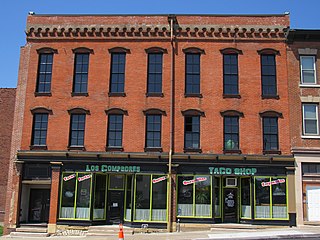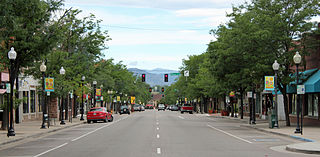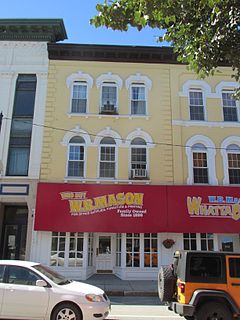History
The Quaintance Block was originally built in 1911 directly on the southeast corner of 13th Street and Washington Avenue, just to the east of its present location. Charles F. Quaintance, a son of pioneers, built this as his new building to house, in its three storefronts, his photo shop (13th Street storefront), Quaintance Realty & Investment Company (corner storefront), and the law office of his brother Arthur (Washington Avenue storefront). A highly astute businessman and promoter, Quaintance strategically located his building across from both of Golden's tramway depots on the opposite corners, luring passengers by advertising his Castle Rock Resort overlooking town. Here, eager patrons would get their photos taken with burros, which would take them up the mountain, and while they were away, Quaintance developed their photos to be ready when the tourists returned. After the resort faded following the advent of the Denver Mountain Parks, Quaintance concentrated on other pursuits. In 1923, Quaintance moved the building 65 feet west to make way for downtown's first stand-alone service station (a Conoco) on the corner, arranging for his building to face upon a courtyard and shifting his rooftop billboard east. Upon his death in 1940, his father, Brough, took over the business until he died in 1946, whereupon the investment company ceased operation.
The building was sold to Ernie Waters, who converted it into the Golden Furniture Store, later owned by Cliff Evans. After Evans consolidated it with another furniture store that he purchased on Washington Avenue, Leonard and Pat Dunn opened the Spudnut Shop here in 1953. Quickly becoming beloved among Goldenites, it was a shop of the national chain which sold, from Alaska to Mexico, delicious donuts made from potato flour ("spud"nuts). Customers often bought them at the shop, while Dunn also sent out delivery boys carrying baskets of Spudnuts, whom he called his "little businessmen". Later owned by Eleanor Laseman, the shop closed when its space was annexed by neighboring Jeffco Blueprints office supply store in 1984. After this closed, the building was faithfully restored to its original appearance in 1990 under direction of Conrad and Ingrid Gardner. Owned by the couple, it houses the Gardner law office and other tenants. The Quaintance Block was designated a Golden and Colorado landmark in 1993 and was listed on the National Register of Historic Places in 1994. It is one of the rare moved buildings to have achieved such high designation, in recognition of its architecture.

Old Pasadena, often referred to as Old Town Pasadena or just Old Town, is the original commercial center of Pasadena, a city in California, United States that arose from one of the most prosperous areas of the state, and had a latter day revitalization after a period of decay.

The Loveland Block and the Coors Building are adjacent historic storefront buildings in downtown Golden, Colorado. The Loveland Block, named for pioneer William A.H. Loveland, once served as the territorial capitol building of Colorado. Both buildings are listed on the National Register of Historic Places as a single entity.

The Musgrove Block is a historic commercial building at 2 Main Street in the center of Andover, Massachusetts. The three story brick building was built in 1895 on the site of a former town green, and forms part of Andover's central Elm Square intersection. The building exhibits Romanesque Revival styling, featuring granite trim elements and ornate brick detailing. It was listed on the National Register of Historic Places in 1982.

The Monroe Avenue Commercial Buildings, also known as the Monroe Block, is a historic district located along a block-and-a-half stretch at 16-118 Monroe Avenue in Detroit, Michigan, just off Woodward Avenue at the northern end of Campus Martius. The district was designated a Michigan State Historic Site in 1974 and listed on the National Register of Historic Places in 1975. The thirteen original buildings were built between 1852 and 1911 and ranged from two to five stories in height. The National Theatre, built in 1911, is the oldest surviving theatre in Detroit, a part of the city's original theatre district of the late 19th century, and the sole surviving structure from the original Monroe Avenue Commercial Buildings historic period.

The Lower Woodward Avenue Historic District, also known as Merchant's Row, is a mixed-use retail, commercial, and residential district in downtown Detroit, Michigan, located between Campus Martius Park and Grand Circus Park Historic District at 1201 through 1449 Woodward Avenue and 1400 through 1456 Woodward Avenue. The district was listed on the National Register of Historic Places in 1999.

The Main Street Historic District in Lake Geneva, Wisconsin is a 2.5-acre (1.0 ha) historic district that was listed on the National Register of Historic Places on January 11, 2002. The listing was amended in some way in a revised listing on March 5, 2002. In 2002, there were 20 buildings in the district that were deemed to contribute to its historic character.

The Masonic Temple Building is a historic Prairie-style building in Oak Park, Illinois, at the corner of Oak Park Avenue and Lake Street. It is in the Ridgeland-Oak Park Historic District and was individually listed on the National Register of Historic Places in 1982.

The Wupperman Block/I.O.O.F. Hall is a historic building located just north of downtown Davenport, Iowa, United States. It was individually listed on the National Register of Historic Places in 1983. In 2020 it was included as a contributing property in the Davenport Downtown Commercial Historic District.

The La Fave Block is located at the intersection of East Cooper Avenue and South Hunter Street in Aspen, Colorado, United States. It is a brick commercial building erected in the late 1880s, during the initial mining boom that created Aspen. Today it is the second oldest brick commercial building in the city, and, along with its neighbors on East Cooper, the only structure left built by Frank LaFave, one of Aspen's early settlers. It was listed on the National Register of Historic Places in 1987.

The Littleton Main Street is a historic district located along W. Main Street, from South Curtice Street, to South Sycamore Street in Littleton, Colorado. The district dates from 1890. The nineteenth century buildings are red pressed brick, many with stone foundations and trim. These buildings replaced smaller frame structures from the pioneer era and proclaimed the success of their builders through solid construction and application of exterior ornament.

The Public Market, also referred to as the Morrill Block, is a historic commercial building at 93-95 Washington Street in Dover, New Hampshire. Built about 1846, it is one of the few surviving Greek Revival commercial buildings in the city, best known for its long association with the local Morrill Furniture Company. It was listed on the National Register of Historic Places in 1985.

The Court Street Commercial Historic District is a largely intact part of the old downtown of Richland Center, Wisconsin. It was added to the National Register of Historic Places in 1989 - a 11.2 acres (4.5 ha) historic district which included 51 contributing buildings and 20 non-contributing ones. The buildings are commercial, mostly in Late Victorian styles constructed from 1870 to 1938. Most are brick two-story buildings; a few one-story and three-story brick buildings are interspersed.

The Alma Downtown Historic District is a commercial historic district in Alma, Michigan, roughly located along Superior Street between the Pine River and Prospect Avenue, and along State Street between Center and Downie Streets. Parts of the district were designated a Michigan State Historic Site in 1975, and the entirety was listed on the National Register of Historic Places in 2013. It contains 72 structures, primarily brick commercial buildings, ranging from one to three stories in height and dating from 1874 to the 1960s.

The Whitehouse Block is a historic commercial building at 188 Water Street in downtown Augusta, Maine. Built in 1865, it is one of a series of four Italianate commercial buildings built in the wake of a devastating 1865 fire. It was listed on the National Register of Historic Places in 1986.

The New Center Commercial Historic District is a commercial historic district located on Woodward Avenue between Baltimore Street and Grand Boulevard in Detroit, Michigan. It was listed on the National Register of Historic Places in 2016.

The Downtown Cheyenne Historic District in Cheyenne, Wyoming is a historic district that was listed on the National Register of Historic Places in 1978. It is an area of about seven blocks, in the core of the original business district of Cheyenne, and home of many of the first masonry commercial buildings in Cheyenne.

The Holland Downtown Historic District is a commercial historic district located along Eighth Street from just east of College Avenue to River Avenue, and along and River Avenue from Ninth Street to just north of Eighth Street in Holland, Michigan. The district was listed on the National Register of Historic Places in 1990.

The East Side Downtown Historic District in Pocatello, Idaho is a historic district which was listed on the National Register of Historic Places in 1994.

The Michigan Avenue Historic Commercial District is a group of commercial buildings located along the south side of two blocks of Michigan Avenue, from 3301–3461, in Detroit. This section of buildings is the most intact collection along this stretch of Michigan Avenue. The district was listed on the National Register of Historic Places in 2020.

The Stoddart Block is a historic building in Downtown Columbus, Ohio. It was listed on the National Register of Historic Places in 1994. The building was constructed in 1911 and designed by the local firm David Riebel & Sons. It was designed for a large furniture store, the Frohock Furniture Company, which operated there until 1938. A second furniture company, Hadley's Furniture Company, occupied the building until 1962. It then operated as the Children's Hospital's thrift shop, from 1962 to 1990. By 2014, the building held 52 low-income apartments. It was renovated into affordable micro-apartments at this time.




















